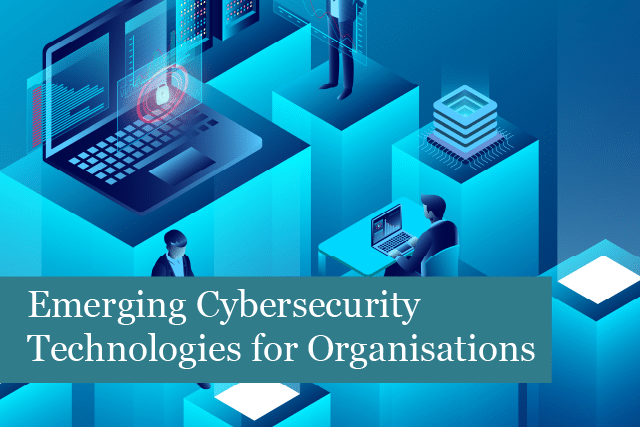
Cybersecurity continues to be a major concern for organisations. Just when they believe they’ve got everything covered, something completely new and different comes along. There’s no room to be complacent when it comes to protecting your business online.
Data Breaches & Other Threats Continue to Increase
Cyberattacks are not slowing down. Data breaches continue to expose millions of data records around the world. The number of attacks and breaches adds up to over 3.5 million pounds and more a year.
When you look at such figures, it’s easy to understand the necessity of making technology upgrades. However, the tried and tested cybersecurity tools we’ve all come to rely on are no longer enough protection.
Emerging Technologies to Watch For
The good news is that there’s an opportunity to watch for emerging technologies that bring higher awareness and offer advanced cybersecurity solutions.
If your business is interested in increasing its security levels, you may want to consider these new technologies that could offer the right solution.
Defensive Artificial Intelligence (AI)
AI has become extremely popular in recent months, bringing with it a wide range of potential tools to different parts of our lives and organisations. However, not many people realise that AI is also making its mark in defensive cybersecurity.
AI and neural networks are being used to augment cybersecurity solutions, especially in areas of pattern matching, predictive analytics, and evaluating data from past events. AI algorithms allow organisations to use 24/7 threat monitoring, with alerts going on when suspicious activities or possible attacks are detected.
There’s definitely room for AI to grow into cybersecurity defence; however, right now, the technology is providing advanced online security workflows and being used extensively in advanced threat detection. Here are some things that AI can offer in cybersecurity:
24/7 Coverage
AI never has to sleep; it’s always running and ready for incoming attacks. AI and neural networks help IT teams and security professionals to react when a threat has been detected.
In addition, AI systems can also be used to respond to protect the network, connected systems, and sensitive data. For instance, AI can disengage the network if a breach is detected. In the process. All users are blocked, and the entire system is locked down. This makes it possible for the security team to investigate without being concerned about damage to the network.
RaaS
Ransomware continues to be a major threat in cybersecurity. The problem is these attacks are quite sophisticated and dangerous.
RaaS (Ransomware as a Service) is a cybercrime that’s becoming more accessible and widespread to bad actors. They’ve worked to develop malicious codes or software that are being outsourced to other criminals. Cybercriminals now have sophisticated tools, money, and motives to wreak havoc on businesses. These tools make it necessary to develop better defences with AI and machine learning to assess and react to these threats.
AI defensive tools are being used to predict attacks, pinpoint vulnerabilities in the network and systems, and prepare IT teams for incoming threats. AI solutions can also dig deeper into malicious code, allowing IT teams to better understand what’s going on and how the system/network is being affected.
Context Aware Behavioural Analytics
Another new security technology is context-aware behavioural analytics. The technology is an excellent tool for organisations that require data leakage protection that meets all the challenges of a multi-device, mobile company.
The problem is that data moves from location to location and is stored on a wide number of devices and in cloud storage applications. The data can be accessed by partners, employees, customers, and more with devices and connections from almost anywhere. For this reason, a dynamic security solution is necessary for monitoring all of these actions.
Context-aware analytics are based on the idea that odd user behaviour may mean that the user’s login credentials have been stolen, and therefore the suspicious activity could lead to a cyberthreat. These solutions rely on environmental factors that can include location and time, devices, IP addresses, abnormal file movements, and other unusual behaviours.
The technology offers an advanced, intelligent solution that can learn and apply pre-defined classifications, scenarios, and policies to huge amounts of data that are used and controlled by a company.
Extended Detection and Response (XDR)
Extended Detection and Response (XDR) is another advanced threat detection and security tool that makes data more visible across multiple products on the IT network, including email, endpoint, server, cloud, and network. As data is collected from these different security layers, XDR visualises and provides context into possible incoming threats and allows companies to conduct faster security analysis and remediation.
XDR is an improved version of Endpoint Detection and Response (EDR), which mainly focuses on endpoint protection, providing visibility and threat detection for specific devices (laptops and more). XDR has a broader approach when it comes to security and integrates analysis and response, not only for endpoints but also for workloads, users, and networks.
Manufacturer Usage Description (MUD)
Another security tool is MUD (Manufacturer Usage Description), which has been specifically designed to mitigate IoT attacks. This security solution is described by US NIST in this way, “A component-based architecture that is designed to provide a means for end devices to signal to the network what sort of access and network functionality they require to properly function.” MUD doesn’t rely on usernames and passwords; instead, security and authentication are built into the hardware.
MUD is an embedded software standard that makes it easy for manufacturers of IoT devices to “broadcast” the device’s specifications so the device can be granted access only on a specific network and nowhere else. The MUD file implements parameters that create a small “DMZ zone” around the devices so they are less vulnerable to attacks.
Summing It Up
As cybercriminals continue to evolve their tactics, the security industry is catching up. The emerging technologies in this article are not able to solve every security issue; however, they give organisations more tools and solutions that can keep them protected against cybersecurity threats.
If your company is searching for enhanced security solutions, be sure to reach out to your IT-managed service provider as soon as possible. They can help you find the right cybersecurity solution for your business.
Recommended Posts

Prepare for Windows 10 End of Life: What You Need to Know
18th July 2025

5 Ways Cloud-Based IT Solutions Can Empower Your UK Business
12th July 2025

Are you making the most of your Microsoft 365 licensing?
4th July 2025
